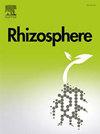丛枝菌根菌丝对真菌和细菌群落结构的影响:原位研究
IF 3.4
3区 生物学
Q1 PLANT SCIENCES
引用次数: 0
摘要
土壤微生物群落是陆地生态系统生物地球化学循环的关键驱动力。然而,在原生土壤条件下,由于植物根系与丛枝菌根真菌(AMF)菌丝密切相互作用,AMF菌丝对土壤微生物群落多样性和丰度的个体影响尚不清楚。采用内生核心设计,从根中分离出AMF菌丝,并利用元条形码测序技术对土壤微生物群落进行定量分析。结果表明,AMF菌丝的存在显著增加了真菌的多样性,但对细菌的多样性没有显著影响。此外,AMF菌丝影响了某些微生物类群的相对丰度:子囊菌门的丰度显著增加,而园艺摩梯菌门和摩梯菌门的丰度显著降低。冗余分析结果表明,土壤养分有效性和土壤pH值与微生物群落密切相关。综上所述,AMF菌丝影响真菌和细菌群落结构,这一过程受土壤性质的调节。这些发现从原位角度为陆地生态系统土壤中AMF菌丝与微生物之间小规模但复杂的相互作用提供了新的见解。本文章由计算机程序翻译,如有差异,请以英文原文为准。
Effect of arbuscular mycorrhizal hyphae on the structure of fungal and bacterial communities: An in situ study
Soil microbial communities are key drivers of biogeochemical cycling in terrestrial ecosystems. However, under native soil conditions, since plant roots intimately interact with arbuscular mycorrhizal fungus (AMF) hyphae, the individual effects of AMF hyphae on the diversity and abundance of soil microbial communities remain unclear. Using an ingrowth core design, we isolated the hyphae of AMF from roots and quantified the affected soil microbial communities using meta-barcoding sequencing techniques. The results revealed that the presence of AMF hyphae significantly increased the diversity of fungi but not that of bacteria. In addition, AMF hyphae influenced the relative abundance of certain microbial taxa: the abundance of the phylum Ascomycota significantly increased, whereas that of the species Mortierella horticola and the phylum Mortierellomycota significantly decreased. The redundancy analysis results revealed that the soil nutrient availability and soil pH were closely related to the microbial community. In conclusion, AMF hyphae affect the structure of fungal and bacterial communities, and this process is regulated by soil properties. These findings provide new insight into the small-scale but complex interactions between the hyphae of AMF and microbes in terrestrial ecosystem soils from an in situ perspective.
求助全文
通过发布文献求助,成功后即可免费获取论文全文。
去求助
来源期刊

Rhizosphere
Agricultural and Biological Sciences-Agronomy and Crop Science
CiteScore
5.70
自引率
8.10%
发文量
155
审稿时长
29 days
期刊介绍:
Rhizosphere aims to advance the frontier of our understanding of plant-soil interactions. Rhizosphere is a multidisciplinary journal that publishes research on the interactions between plant roots, soil organisms, nutrients, and water. Except carbon fixation by photosynthesis, plants obtain all other elements primarily from soil through roots.
We are beginning to understand how communications at the rhizosphere, with soil organisms and other plant species, affect root exudates and nutrient uptake. This rapidly evolving subject utilizes molecular biology and genomic tools, food web or community structure manipulations, high performance liquid chromatography, isotopic analysis, diverse spectroscopic analytics, tomography and other microscopy, complex statistical and modeling tools.
 求助内容:
求助内容: 应助结果提醒方式:
应助结果提醒方式:


